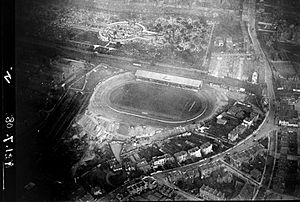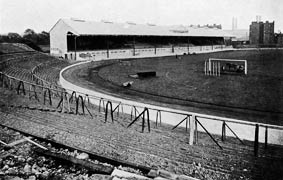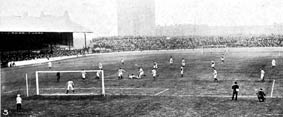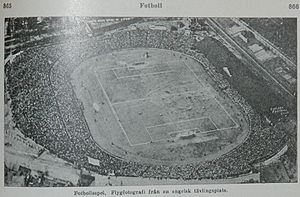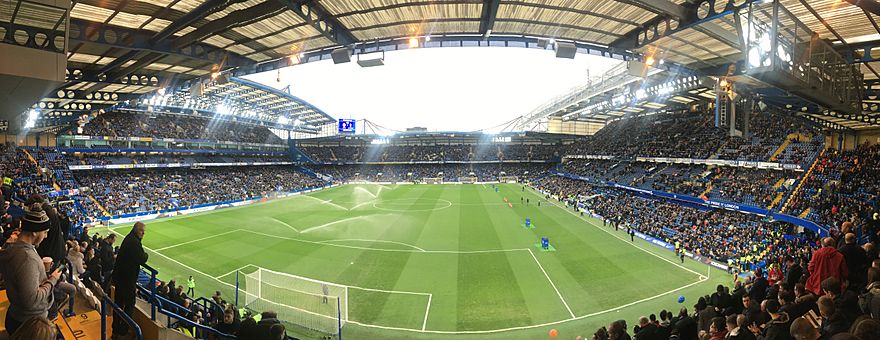Stamford Bridge (stadium) facts for kids
|
"The Bridge"
|
|
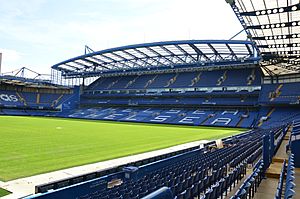
Stamford Bridge in 2013
|
|
| Full name | Stamford Bridge |
|---|---|
| Location | Fulham, London, SW6 England |
| Coordinates | 51°28′54″N 0°11′28″W / 51.48167°N 0.19111°W |
| Public transit | |
| Owner | Chelsea Pitch Owners |
| Operator | Chelsea Football Club |
| Executive suites | 51 |
| Capacity | 40,341 |
| Record attendance | 82,905 (Chelsea–Arsenal, 12 October 1935) |
| Field size | 113 by 74 yards (103.3 m × 67.7 m) |
| Surface | GrassMaster by Tarkett Sports |
| Construction | |
| Built | 1876 |
| Opened | 28 April 1877 |
| Renovated | 1904–1905, 1998 |
| Architect | Archibald Leitch (1887) |
| Tenants | |
| London Athletic Club (1877–1904) Chelsea F.C. (1905–present) London Monarchs (NFL Europe) (1997) |
|
Stamford Bridge is a football stadium in Fulham, adjacent to the borough of Chelsea in West London. It is the home of Premier League club Chelsea. With a capacity of 40,341, it is the ninth largest venue of the 2022–23 Premier League season and the eleventh largest football stadium in England.
Opened in 1877, the stadium was used by the London Athletic Club until 1905, when new owner Gus Mears founded Chelsea Football Club to occupy the ground; Chelsea have played their home games there ever since. It has undergone major changes over the years, most recently in the 1990s when it was renovated into a modern, all-seater stadium.
Stamford Bridge has been a venue for England international matches, FA Cup Finals, FA Cup semi-finals and Charity Shield games. It has also hosted numerous other sports, such as cricket, rugby union, rugby league, speedway, greyhound racing, baseball and American football. The stadium's highest official attendance is 82,905, for a league match between Chelsea and Arsenal on 12 October 1935.
Contents
History
Early history
"Stamford Bridge" is considered to be a derivative of "Samfordesbrigge" meaning "the bridge at the sandy ford". Eighteenth century maps show a "Stanford Creek" running along the route of what is now a railway line at the back of the East Stand as a tributary of the Thames. The upper reaches of this tributary have been known as Billingswell Ditch, Pools Creek and Counters Creek. In medieval times the creek was known as Billingwell Dyche, derived from "Billing's spring or stream". It formed the boundary between the parishes of Kensington and Fulham. By the 18th century, the creek had become known as Counter's Creek, which is the name it has retained since.
The stream had two local bridges: Stamford Bridge on the Fulham Road (also recorded as Little Chelsea Bridge) and Stanbridge on the King's Road, now known as Stanley Bridge. The existing Stamford Bridge was built of brick in 1860–1862 and since been partly reconstructed.
Stamford Bridge opened in 1877 as a home for the London Athletic Club and was used almost exclusively for that purpose until 1904, when the lease was acquired by brothers Gus and Joseph Mears, who wanted to stage high-profile professional football matches there. However, previous to this, in 1898, Stamford Bridge played host to the World Championship of shinty between Beauly Shinty Club and London Camanachd. Stamford Bridge was built close to Lillie Bridge, an older sports ground which had hosted the 1873 FA Cup Final and the first ever amateur boxing matches (among other things). It was initially offered to Fulham Football Club, but they turned it down for financial reasons. After considering the sale of the land to the Great Western Railway Company, the Mears decided to found their own football club, Chelsea, to occupy the ground as a rival to Fulham. Noted football ground architect Archibald Leitch, who had also designed Ibrox, Celtic Park, Craven Cottage and Hampden Park, was hired to construct the stadium. In its early days, Stamford Bridge stadium was served by a small railway station, Chelsea and Fulham railway station, which was later closed after World War II bombing.
Stamford Bridge had an official capacity of around 100,000, making it the second largest ground in England after Crystal Palace. It was used as the FA Cup final venue. As originally constructed, Stamford Bridge was an athletics track and the pitch was initially located in the middle of the running track. This meant that spectators were separated from the field of play on all sides by the width of running track and, on the north and south sides, the separation was particularly large because the long sides of the running track considerably exceeded the length of the football pitch. The stadium had a single stand for 5,000 spectators on the east side. Designed by Archibald Leitch, it was an exact replica of the Stevenage Road Stand he had previously built at the re-developed Craven Cottage (and the main reason why Fulham had chosen not to move into the new ground). The other sides were all open in a vast bowl and thousands of tons of material excavated from the building of the Piccadilly line provided high terracing for standing spectators exposed to the elements on the west side.
In 1945, Stamford Bridge staged one of the most notable matches in its history. Soviet side FC Dynamo Moscow were invited to tour the United Kingdom at the end of the Second World War and Chelsea were the first side they faced. An estimated crowd of over 100,000 crammed into Stamford Bridge to watch a 3–3 draw, with many spectators on the dog track and on top of the stands.
Crisis
In the early 1970s the club's owners initiated a project to renovate Stamford Bridge. However, the cost of building the East Stand escalated out of control after shortages of materials and a builders' strike and the remainder of the ground remained untouched. The new East Stand was finished, but most of the (unusable) running tracks remained, and the new stand was also displaced by approximately 20 meters, compared to the pitch. The idea was to move the entire stadium towards the north. But due to the financial situation in the mid-1970s the other stands were not rebuilt for another two decades. In the meantime, Chelsea struggled in the league, and attendances fell and debts increased. The club was relegated to the Second Division in 1975 and again in 1979, narrowly avoiding the drop into the Third Division in 1983 before finally returning to the First Division a year later.
The increase in the costs, combined with other factors, sent the club into decline. As a part of financial restructuring in the late 1970s, the freehold was separated from the club and when new Chelsea chairman Ken Bates bought the club for £1 in 1982, he did not buy the ground. A large chunk of the Stamford Bridge freehold was subsequently sold to property developers Marler Estates. The sale resulted in a long and acrimonious legal fight between Bates and Marler Estates. Marler Estates was ultimately forced into bankruptcy after a market crash in the early 1990s, allowing Bates to do a deal with its banks and re-unite the freehold with the club.
During the 1984–85 season, following a series of pitch invasions and fights by football hooligans during matches at the stadium, chairman Ken Bates erected an electric perimeter fence between the stands and the pitch – identical to the one which effectively controlled cattle on his dairy farm. However, the electric fence was never turned on and before long it was dismantled, due to the GLC blocking it from being switched on for health and safety reasons.
Modernisation and redevelopment
With the Taylor Report arising from the Hillsborough disaster being published in January 1990 and ordering all top division clubs to have all-seater stadiums in time for the 1994–95 season, Chelsea's plan for a 34,000-seat stadium at Stamford Bridge was given approval by Hammersmith and Fulham council on 19 July 1990.
The re-building of the stadium commenced and successive building phases during the 1990s eliminated the original running track. The construction of the East Stand some 20 years earlier had begun the process of eliminating the track. All stands, now roofed and all-seater, are immediately adjacent to the pitch. This structure captures and concentrates the noise of supporters. The pitch, the turnstiles, and the naming rights of the club are now owned by Chelsea Pitch Owners, an organisation set up to prevent the stadium from being purchased by property developers.
KSS Design Group (architects) designed the complete redevelopment of Stamford Bridge Stadium and its hotels, megastore, offices and residential buildings.
Other uses
Stamford Bridge was the venue of the FA Cup Final from 1920 to 1922, before being replaced by Wembley Stadium in 1923. It has staged ten FA Cup semi-finals, ten Charity Shield matches, and three England matches, the last in 1932. It was one of the home venues for the representative London XI team that played in the original Inter-Cities Fairs Cup. The team played the home leg of the two-legged final at Stamford Bridge, drawing 2–2 with FC Barcelona; they lost the away leg 6–0, however.
Stamford Bridge has also hosted a variety of other sporting events since Chelsea have occupied the ground. In October 1905 it hosted a rugby union match between the All Blacks and Middlesex, and in 1908, Stamford Bridge was the venue for a Rugby League international between Great Britain and the touring New Zealand All Golds, who won 18–6. Two New Zealanders George Smith and William "Massa" Johnston played and scored in both these games. Two further Rugby League games were held in 1952, British Empire XIII v New Zealand, and 1983, Fulham v Cardiff. In 1914 Stamford Bridge hosted a baseball match between the touring New York Giants and the Chicago White Sox. In 1924 the stadium hosted the 1924 Women's Olympiad, the first international event for women in track and field in the UK. A speedway team operated from the stadium from 1929 until 1932, winning the Southern League in their opening season. Initially open meetings were held there in 1928. A nineteen-year-old junior rider, Charlie Biddle, was killed in a racing accident. In 1931, black cinders were laid onto the circuit suitable for use by speedway and athletics. A midget car meeting reportedly attracted a crowd of 50,000 people in 1948.
The ground was used in 1980 for the first major day-night floodlit cricket match between Essex and West Indies (although organised by Surrey) which was a commercial success; the following year it hosted the final of the inaugural Lambert & Butler county cricket competition. It, however, failed and the experiment of playing cricket on football grounds was ended. Stamford Bridge briefly hosted American football – despite not being long enough for a regulation-size gridiron field – when the London Monarchs were based there in 1997.
Centenary Museum
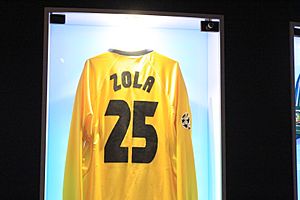
2005 saw the opening of a new club museum, known as the Chelsea Museum or the Centenary Museum, to mark the one hundredth anniversary of the club. The museum is located in the former Shed Galleria. Visitors are able to visit the WAGs lounge and then watch an introductory video message from the former vice-president Richard Attenborough. They are then guided decade by decade through the club's history seeing old programmes, past shirts, José Mourinho's coat and other memorabilia. A motto on the wall of the museum reads "I am not from the bottle. I am a special one.", a reference to Mourinho's famous quote upon signing as manager for Chelsea.
On 6 June 2011 a new museum with improved and interactive exhibits opened behind the Matthew Harding stand. It is the largest football museum in London.
Megastore
The club merchandise shop, known as the Megastore, is situated on the south-west corner of the stadium. The shop has two floors; the ground floor mainly consists of souvenirs and children's gear, and the first floor offers mainly apparel, including training jerseys, jackets, coats, and replica team jerseys. There are also two smaller shops, one located at the Stamford Gate entrance and the other inside the new museum building behind the Matthew Harding stand.
The Stamford Bridge Redevelopment Project
Former Chelsea owner Roman Abramovich sanctioned redevelopment of Stamford Bridge to around 55,000 to 60,000 seats. Its location in a heavily built-up part of Inner London, in between a main road and two railway lines complicates the logistics of the redevelopment. Additionally, dispersing 60,000 fans into the residential roads surrounding Stamford Bridge is likely to create congestion.
Alternative sites
Earls Court Exhibition Centre, White City, Battersea Power Station, the Imperial Road Gasworks (off the Kings Road on the Fulham and Chelsea border), and the Chelsea Barracks were probable alternative sites explored for a stadium rebuild. Under the Chelsea Pitch Owners (CPO) articles of association, the club would however relinquish the name 'Chelsea Football Club' should it ever move from the site where Stamford Bridge exists. The club proposed to buy back the freehold from CPO. In a vote held on 27 October 2011, its shareholders opted against selling their rights.
On 4 May 2012, Chelsea announced a bid to purchase Battersea Power Station to build a 60,000-seater stadium on the site. They released artistic impressions of the proposed stadium on 22 June 2012.
Proposed plan
On 17 June 2014, club announced that it had commissioned a study of the area from Fulham Broadway to Stamford Bridge and beyond, by architects Lifschutz Davidson Sandilands. Later, in December next year, Chelsea announced intention to build a 60,000-seater stadium at Stamford Bridge.
On 5 January 2017 Hammersmith and Fulham council approved the rebuild. The whole of Chelsea village would be demolished and the new stadium would include a new club shop, museum, a bar, and restaurants. The two existing hotels, restaurants, bars and spa would be relocated.
On 6 March 2017 full permission was given to redevelop Stamford Bridge by the mayor of London, Sadiq Khan, who said the "high quality and spectacular design" would add to the capital's "fantastic array of sporting arenas".
During the rebuild, expected to last 3–4 years, the club would have to find an alternative site to play home games. The Twickenham Stadium emerged as one possible destination. In February 2016, media reports claimed that Chelsea had agreed a £20 million deal with the FA for Wembley Stadium to use it for three seasons beginning in 2017–18. Although, Chelsea wanted exclusive rights to Wembley, the FA suggested that they share stadium with London-rivals Tottenham Hotspur F.C. for just the 2017–18 season, as Spurs were then engaged in their own stadium rebuild. The FA wanted to show no favourites in using the national stadium.
Redesign
The Gothic, Westminster Abbey-inspired redesign, envisioned as a "cathedral of football", prominently features a series of 132 brick piers interlaced with 132 slender steel piers, in reference to the borough's Victorian-era brick works, that extend over the roof and end in a circular white steel ring right above the pitch. The piers create a covered walkway around the perimeter of the premises.
The unusual faceted polygon shape of the stadium accommodates site constraints such as neighbouring properties, rights to light, rails, historic boundary walls, whilst maximising its interior space. With five levels above ground and three basement levels, and five general admission entrances and four hospitality entrances to a three-tiered spacious spectator bowl across four stands, the rebuild's principal emphasis is on match-day atmosphere and spectator experience; including views of the pitch from all seats in the stadium, easier stadium access, and the season-ticket holders keeping their respective seating positions. A pair of continuous 'inner' and 'outer' rings occupying approximately 60,000 m2 around the bowl houses concourse facilities like dining areas, kiosks, washrooms, kitchens, and first-aid rooms. The façade, made up of 264 piers, is left open or is covered with opaque panels and translucent glass. The front panels feature decorative architectural metal known as Crozier. The public plazas are augmented by an additional 23,000 m2 through covering of the railway lines bordering its perimeter. According to Herzog & de Meuron, the architects, the design is intended to "capture the spirit of the local heritage in a contemporary sculpted form that will respond to the local townscape [...] The structure will have a lightness of expression when viewed directly but also a solidity and textural materiality when seen obliquely".
Involving excavation activities and demolition of the existing stadium and the associated buildings, the rebuild, touted as "one of the most ambitious and difficult builds in architectural history", is expected to cost $754 million. Herzog & de Meuron, redesigned the stadium based on the master-plan drafted by Lifschutz Davidson Sandilands, while Aecom provided environmental, fire, mechanical, electrical, and plumbing engineering and were also landscape architects. Parsons Brinckerhoff and Schlaich Bergermann Partner worked on its structural and civil engineering aspects.
New plan
In July 2022, it was reported that the club's new owner Todd Boehly had appointed American architect Janet Marie Smith to oversee the renovation of the stadium.
Statistics
Records
- Record attendance: 82,905 v Arsenal F.C. on 12 October 1935
- Lowest attendance: 3,000 at a Chelsea v Lincoln match in 1906
International matches
- 11 December 1909: England Amateurs 9–1 Netherlands
- 5 April 1913: England 1–0 Scotland
- 20 November 1929: England 6–0 Wales
- 7 December 1932: England 4–3 Austria
- 11 May 1946: England 4–1 Switzerland (Victory International)
- 25 March 2013: Brazil 1–1 Russia
Access
Stamford Bridge is easily accessible by public transport. The closest London Underground station – Fulham Broadway – has a dedicated "match day" entrance, allowing crowds easier entry/exit from the station, avoiding the main ticket hall and shopping centre. Given the stadium's location in south west London, car parking in the local area is extremely limited – and therefore the use of public transport is recommended by Chelsea FC and local supporter groups.
| Service | Station/Stop | Line/Route | Walking distance from Stamford Bridge |
|---|---|---|---|
| London Buses |
Walham Green | 11, 14, 211, 414, N11 | 200 yards (180 m) 2 mins |
| Fulham Broadway/ Fulham Town Hall |
28, 295, 391, 424, N28 | 0.2 miles (0.32 km) 5 mins | |
| London Underground |
Fulham Broadway | District line | 0.2 miles (0.32 km) 5 mins |
| Earl's Court | District line Piccadilly line |
1.1 miles (1.8 km) 27 mins | |
| National Rail London Overground |
West Brompton | London Overground | 0.8 miles (1.3 km) 20 mins |
| Imperial Wharf | 0.625 miles (1.006 km) 13 mins | ||
| London River Services |
Chelsea Harbour Pier | London River Services | 0.75 miles (1.21 km) 15 mins |
See also
 In Spanish: Stamford Bridge (estadio) para niños
In Spanish: Stamford Bridge (estadio) para niños


